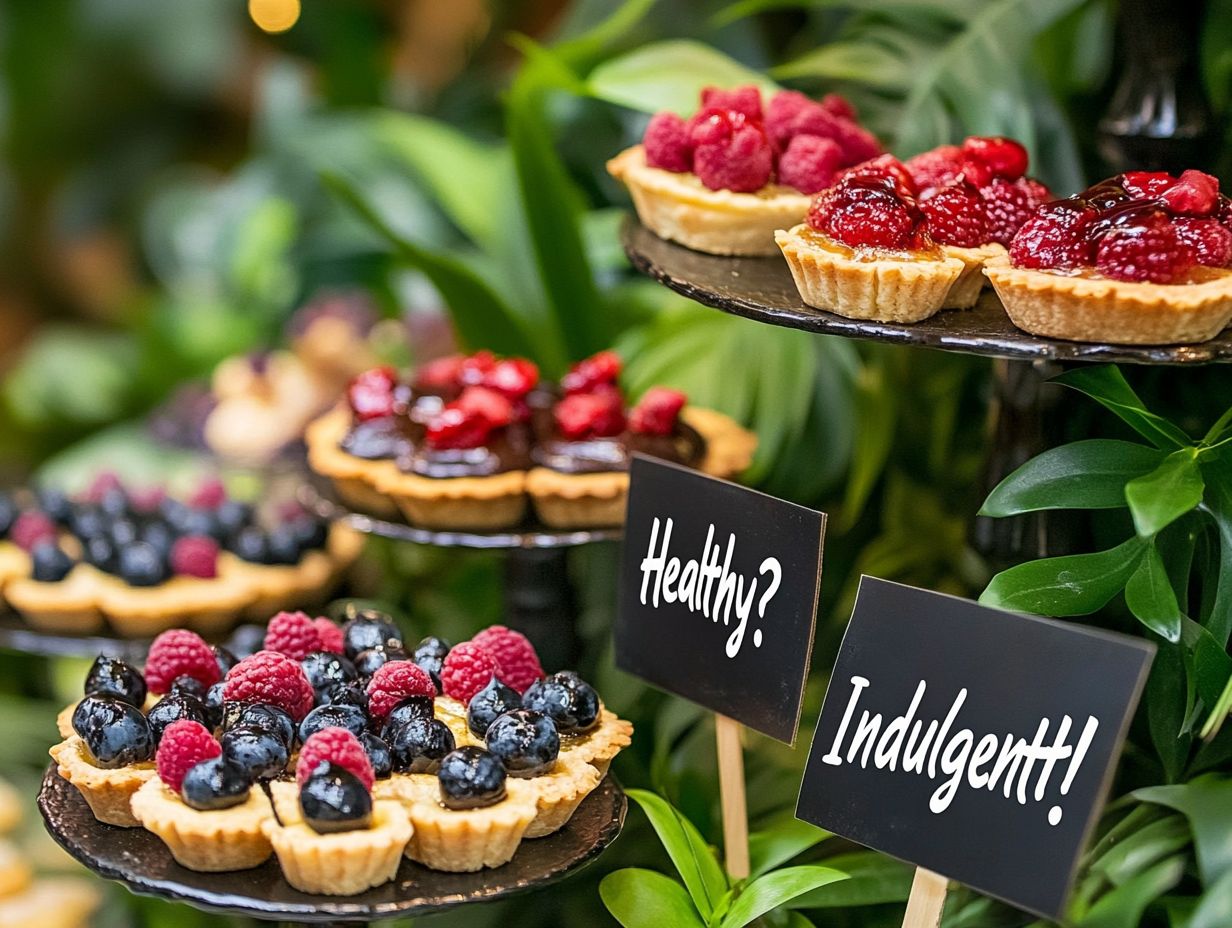Are Desserts Healthy? Common Misconceptions
Desserts indeed hold a special place in your heart and kitchen, yet they often come wrapped in a cloud of misconceptions and guilt. You may find yourself believing that indulging in sweets equates to unhealthy eating or that desserts are only meant for celebrations or children.
This article is here to debunk those myths and guide you toward healthier dessert options that will satisfy your sweet tooth without jeopardizing your well-being. You’ll discover how to enjoy desserts in a balanced manner while also learning tips to make your treats equally delicious and nutritious. Understanding key nutrition facts and health tips can help you make better choices.
Contents
- Key Takeaways:
- What Are Desserts?
- What Are The Common Misconceptions About Desserts?
- 5. Sugar-Free Desserts Are Healthier
- What Are The Healthier Dessert Options?
- Healthier Dessert Options
- 5. Chia Seed Pudding
- How Can You Make Your Desserts Healthier?
- 1. Use Natural Sweeteners
- 2. Incorporate Whole Grains
- Frequently Asked Questions
Key Takeaways:
What Are Desserts?
Desserts, those delightful sweet creations, often grace the table at the end of a meal. Crafted from ingredients like sugar, flour, and an array of flavorings, they encompass a spectrum that ranges from indulgent cakes and pastries to more health-conscious options like fruit-based treats or Greek yogurt.
By grasping the subtleties of desserts, you can make informed choices that align with your dietary goals, particularly when it comes to managing sugar consumption and caloric density for optimal weight control and overall well-being. With the right knowledge and a dash of moderation, you can seamlessly incorporate desserts into a well-rounded approach to health and nutrition.
What Are The Common Misconceptions About Desserts?
Despite their undeniable allure, desserts often come with a host of misconceptions that can cloud your judgment and impact your health goals. It s common to think that indulging in desserts will inevitably result in weight gain or that they should be entirely eliminated when embarking on the latest fad diets.
However, by unraveling the myths surrounding desserts, you can give the power to yourself to make informed choices that support your health objectives while still savoring life’s sweet moments. The truth is, moderation is essential. When approached thoughtfully, enjoying desserts can seamlessly fit into a balanced diet, enhancing rather than hindering your wellness journey. Remember, consulting your primary-care provider before making significant dietary changes can also be beneficial.
1. Desserts Are Unhealthy
The idea that all desserts are unhealthy is a common misconception you might encounter; in reality, many desserts can be both satisfying and nutritious when crafted with wholesome ingredients and appropriate portion sizes. Consider healthy options like chia pudding, yogurt parfaits, and baked fruit crisps they provide essential nutrients while still delighting your sweet tooth. By concentrating on energy balance and making smarter ingredient choices, you can relish desserts without compromising your health. Including desserts in your diet can be a part of a well-rounded exercise and diet regimen.
The secret lies in choosing nutrient-dense alternatives to those sugar-laden indulgences. For instance, swapping out refined flour for whole grains, such as oats or almond flour, not only boosts fiber content but also supports sustained energy levels. Incorporating natural sweeteners like honey or maple syrup in moderation can fulfill your cravings without causing the blood sugar spikes often tied to processed sugars. Adding fruits, nuts, or seeds introduces healthy fats, vitamins, and minerals, enriching your dessert’s profile and transforming it into a wholesome indulgence. Using whole grain flour instead of processed carbs can also contribute to maintaining a healthier diet.
By understanding these ingredient choices, you can create delightful desserts that nourish your body while tantalizing your taste buds.
2. All Desserts Are High In Calories
There’s a common misconception that all desserts come with a hefty calorie price tag. The truth is, the number of calories in a food compared to its weight varies among different types of desserts. For example, take a slice of Middle Eastern baklava; it likely has a higher caloric density than a light, fruit-based dessert like berry compote or a refreshing chia seed pudding.
By opting for lower-calorie choices and practicing portion control, you can savor desserts without tipping the scales too far. Keeping an eye on carbohydrates can also help manage caloric intake.
Understanding caloric density is key when making dessert decisions. It helps you find satisfying treats and promotes a more mindful approach to indulgence. High-calorie desserts often boast rich ingredients like cream, butter, and refined sugars, which can skyrocket their calorie counts. In contrast, desserts that feature fruits, whole grains, or healthy fats can deliver delightful flavors while keeping the caloric values in check.
Even processed carbs found in traditional desserts can be managed with proper choices. You can navigate the world of desserts with ease by focusing on moderation. Opt for smaller servings of richer desserts or pick lighter alternatives. This way, you can satisfy your sweet tooth without derailing your dietary ambitions.
3. Desserts Are Only For Special Occasions
Believing that desserts are only for special occasions can lead to unnecessary feelings of deprivation and cravings, which may derail your journey toward sustained health. Desserts can and should be enjoyed in moderation as part of a balanced lifestyle. They provide both pleasure and satisfaction in your everyday meals.
Incorporating healthy desserts into your daily routine not only satisfies those sweet cravings but also supports your overall well-being. For example, choosing fruit-based treats, yogurt parfaits, or dark chocolate snacks can deliver delightful sweetness without compromising your nutritional goals.
These healthier choices tantalize your taste buds while packing in essential nutrients that enhance your mood and energy levels. Allowing yourself to indulge in treats while keeping it moderate can relieve feelings of guilt and deprivation. This fosters a more positive relationship with food.
Weaving these desserts into your weekly meal plan can promote mindful eating while still relishing life’s sweet moments. This approach helps maintain a balanced and sustainable approach to your dietary habits.
4. Desserts Are Only For Children

The notion that desserts are just for children misses the mark entirely. Anyone can indulge in sweets, and many desserts can be expertly crafted to cater to adult palates and dietary preferences. You can savor complex flavors and enjoy healthier twists on traditional favorites.
For instance, indulge in dark chocolate confections or Greek yogurt desserts, relishing in the pleasure of indulgence while prioritizing your health. Consider the depth of flavors in creations like matcha green tea cookies or almond flour cakes. These desserts transform a simple sweet into a refined culinary experience.
By opting for natural sweeteners and incorporating superfoods, you can delight health-conscious cravings without compromising on taste. Collaborations with chefs like Chef Rubina Hafeez can also provide unique healthy dessert recipes.
The textures and exquisite presentation of these treats infuse a sense of elegance. They are perfect for special occasions or simply for treating yourself. For example, a tart made with seasonal fruits and a nut-based crust delivers a refreshing burst of flavor and appeals to those who appreciate mindful eating options.
Find inspiration from Instagram posts showcasing beautiful and healthy desserts. Explore healthy dessert recipes or try making your own to enjoy the sweetness in life!
5. Sugar-Free Desserts Are Healthier
While sugar-free desserts may seem like a healthier choice, it’s vital for you to assess their overall health benefits. Many sugar substitutes, such as agave nectar, can introduce other dietary complications or flavors that might not align with your health goals. Understanding the ingredients and practicing moderation is key to determining which desserts genuinely support your well-being. Consulting with a healthcare provider can also provide insights into the best choices for your diet.
Many people believe that if a dessert is labeled ‘sugar-free,’ it must automatically be healthy. But that’s not always the case! For example, some sugar-free products lean heavily on artificial sweeteners, which can lead to digestive discomfort or other health issues for some people. Checking the nutrition facts on these products can provide a better understanding of their overall health impact.
By comparing these alternatives to traditional desserts, you can appreciate the significance of whole-food ingredients like nuts, fruits, and natural sweeteners such as honey or maple syrup. These not only provide sweetness but also offer valuable nutrients. Including whole grains in your desserts can further boost their nutritional value.
Enjoying desserts in a balanced manner regardless of their sugar content can foster a more satisfying and health-conscious approach to indulgence. Consulting your primary-care provider can also aid in making healthier choices.
What Are The Healthier Dessert Options?
In the world of desserts, healthier options are plentiful, ready to satisfy your sweet cravings while enhancing your overall well-being. Picture fruit-based desserts that harness the power of natural sweetness or indulge in decadent yet nutritious treats like dark chocolate. You might find inspiration from chefs like Kiran Ansari or Salad Box when creating these desserts.
You can relish desserts without sacrificing your health. By incorporating whole grains and nutrient-rich toppings, you can elevate these delightful options, crafting guilt-free indulgences that everyone can truly appreciate. Drawing on recipes from dessert experts like Dalia Hassabala can also provide creative and healthy dessert ideas.
1. Fruit-Based Desserts
Fruit-based desserts offer a splendid way to indulge your sweet tooth while enjoying the many health benefits of fresh produce. By harnessing the natural sweetness of fruits like berries, bananas, or apples, you can create desserts that are rich in vitamins, minerals, and fiber all essential for a balanced diet. Think of options like vibrant fruit salads or warm baked fruit crisps, both of which can easily become your go-to choices for healthy indulgence. For those watching their weight, these options can also support weight loss efforts.
Beyond the traditional offerings, you might want to explore delightful creations such as coconut-infused mango pudding or chia seed pudding adorned with seasonal fruits. These not only tantalize your palate but also enhance your nutritional intake. Crafting fruity compotes or refreshing sorbets can serve as delectable alternatives to conventional sugary treats, brimming with antioxidants that help fight harmful substances in the body.
To further elevate the flavors of your desserts, consider incorporating spices like cinnamon or vanilla. This approach accentuates the natural sweetness of the fruit, eliminating the need for added sugars. Embracing the versatility of fruits in your dessert creations not only supports your health but also invites a sense of creativity into your kitchen endeavors. Renowned chefs like Chef Rubina Hafeez have praised this method for its ability to transform simple ingredients into gourmet desserts.
Visit local cafes or try these recipes at home to discover the joy of healthy desserts!
Healthier Dessert Options
2. Dark Chocolate
Dark chocolate is celebrated for its many health benefits. It serves as a luxurious and satisfying dessert choice that you can relish in moderation.
Rich in antioxidants and unique flavor profiles, dark chocolate can enhance heart health and cognitive function. It s a superb addition to your balanced diet. When you enjoy a small piece of high-quality dark chocolate, you’re not just treating yourself you re making a health-conscious decision, supported by organizations like the World Health Organization.
The nutritional profile of dark chocolate is nothing short of impressive. It is brimming with essential minerals like iron, magnesium, and zinc, and it s also loaded with flavonoids, known for their ability to reduce inflammation and lower blood pressure. Even diet plans such as the Atkins Diet and Keto allow for dark chocolate in moderation due to these benefits.
When searching for quality dark chocolate, aim for products with at least 70% cocoa content; these options typically provide greater health benefits and less sugar.
Try out these exciting ideas for your desserts:
- Grating dark chocolate over a fresh fruit salad
- Blending it into your favorite smoothies
- Using it in baking recipes like rich brownies or velvety chocolate mousse
Embrace these suggestions to savor the indulgent sweetness of dark chocolate while enjoying its remarkable health benefits.
3. Yogurt Parfaits
Yogurt parfaits, especially those crafted with Greek yogurt, present you with a delightful and nutritious dessert option that boasts both protein and probiotics. By layering creamy yogurt with fresh fruits, nuts, and a drizzle of honey, you create a visually stunning treat that satisfies your cravings while prioritizing your health. Many health enthusiasts like Ryden Anderson and Kiran Ansari have popularized these parfaits on Instagram, showcasing their endless customization possibilities.
With a variety of toppings at your disposal, yogurt parfaits can easily cater to your unique taste preferences while delivering essential nutrients. Imagine delightful layers that include granola for that satisfying crunch, seeds for an extra nutritional boost, or even a sprinkle of cinnamon to elevate the flavor profile. Greek yogurt is celebrated for its rich, creamy texture and impressive protein content, making it an ideal choice for promoting a feeling of fullness.
To keep your yogurt parfaits fresh and exciting, why not experiment with seasonal fruits? Berries in the summer or crisp apples in the fall can add delightful twists. You can also explore alternative sweeteners or flavored yogurts, personalizing each parfait to ensure it remains a delightful treat tailored to your dietary needs. Caf s like Salad Box offer a variety of these parfaits, using local and fresh ingredients.
4. Baked Fruit Crisps

Baked fruit crisps offer a delightful way for you to savor the natural sweetness of fruits while enjoying a nutritious crunch from whole grains. By baking fresh fruits and topping them with a blend of oats, nuts, and spices, you create a dessert that not only provides fiber but also packs essential nutrients, making it an outstanding healthy dessert option. With their simplicity and customization potential, baked fruit crisps can be a comforting treat any time of year. Dessert artisans like Iulia H d rean and Dalia Hassabala often feature baked fruit crisps in their gourmet offerings.
With a bounty of fruits available throughout the seasons, you can easily swap apples for peaches in the summer or pears in the fall, allowing you to showcase the fresh flavors of whatever is in season. Opting for natural sweeteners like honey or maple syrup instead of refined sugars can elevate both the taste and health benefits of your dessert.
Don t hesitate to experiment with different spices think cinnamon or nutmeg to introduce a warmth and depth that will truly enhance the dish. This versatile dessert invites your creativity, enabling you to mix and match based on your personal preferences and nutritional needs. Incorporating elements from Middle Eastern baklava or Indian kulfi can add an exotic twist to your baked fruit crisps.
Whether you serve them warm with a dollop of yogurt or enjoy them on their own, baked fruit crisps present a wholesome indulgence that is bound to please everyone.
5. Chia Seed Pudding
Chia seed pudding has become a go-to option for those seeking a healthy dessert. Its intriguing texture and remarkable nutritional benefits make it a delightful choice for the health-conscious. Packed with fiber, omega-3 fatty acids, and protein, this pudding can be effortlessly enhanced with fruits, nuts, or natural sweeteners like agave nectar.
This pudding is often featured in Caribbean cuisine, celebrated for its versatility and nutritional value.
Preparing chia seed pudding is a breeze. It requires only a handful of ingredients and minimal effort. With just chia seeds, your choice of a liquid base such as almond milk or coconut milk, and a little patience for the seeds to absorb the liquid and thicken, you can whip up a satisfying treat without needing to be a culinary expert.
This dish serves not only as a scrumptious dessert but also as a nourishing breakfast or snack option throughout the day.
The possibilities are endless, inviting you to unleash your creativity in the kitchen. Whether you opt for a decadent chocolate version or prefer a refreshing tropical twist with pineapple and mango, the rich texture and nutritional perks make it an ideal indulgence for anyone looking to enjoy something delicious yet wholesome.
How Can You Make Your Desserts Healthier?
Transforming desserts into healthier delights is entirely within your reach with just a few thoughtful changes to your ingredient selections and preparation techniques.
By opting for natural sweeteners like agave nectar or honey and swapping out refined flour for wholesome whole grains, you elevate the nutritional value of your beloved treats. Creative toppings and portion control can significantly enhance your dessert experience, all while still indulging your cravings.
1. Use Natural Sweeteners
Using natural sweeteners instead of refined sugars can significantly elevate the healthfulness of your desserts. These sweeteners offer not just sweetness but a boost of nutrients as well. Options like agave nectar, honey, or pure maple syrup can enhance the flavor of your treats while lowering their overall glycemic impact. This makes them a more health-conscious choice for discerning dessert lovers.
These alternatives provide unique flavors and come with their own health benefits. For example, honey is renowned for its antioxidant properties, while agave nectar boasts a lower glycemic index. This makes it a smart option for those who keep an eye on their blood sugar levels.
When you’re whipping up desserts like cookies or cakes, consider swapping refined sugars for pure maple syrup, which adds a delightful caramel-like essence. This change not only elevates the flavor profile of your dessert but infuses it with vitamins and minerals. This way, you can indulge in a healthier manner.
Incorporating these natural sweeteners into your baking allows you to craft delicious treats that harmonize beautifully with a balanced diet.
2. Incorporate Whole Grains
Incorporating whole grains into your desserts is a brilliant way to enhance their nutritional value while adding delightful flavor and texture. By swapping refined flours for whole grain alternatives like whole wheat or almond flour, you infuse your treats with essential nutrients and fiber that support your digestive health. This creates a more satisfying experience.
Take chocolate chip cookies, for example. Using whole wheat flour boosts their nutrient profile and introduces a subtle nuttiness that beautifully complements the sweetness of the chocolate. Almond flour, on the other hand, works wonders in moist cakes, providing a delightful crumb and a rich flavor that elevates the entire indulgence.
Imagine making delicious whole grain brownies by blending oat flour with cocoa powder for a fudgy treat that’s also heart-healthy. Even pancakes can join this wholesome movement; simply substitute all-purpose flour with spelt flour for a unique twist on a beloved breakfast classic.
These straightforward alterations demonstrate that desserts can be both nutritious and utterly delicious. As Chef Rubina Hafeez often says, even a simple treat can be a masterpiece.
So, why not start experimenting with these healthier alternatives in your next dessert? Share your creations in the comments below!
3. Add Nutritious Toppings
Elevating your desserts with nutritious toppings not only enhances their health benefits but also boosts flavor and presentation. Think about it: fresh fruits, nuts, seeds, and even yogurt can infuse essential nutrients, antioxidants, and healthy fats, transforming simple desserts into supercharged delights that are both satisfying and wholesome.
Picture this: drizzling a tart berry compote over a creamy cheesecake. Not only does it add an explosion of flavor, but it also provides a generous dose of antioxidants. Or imagine topping a rich chocolate mousse with sliced almonds; this adds a delightful crunch while delivering heart-healthy fats. Greek yogurt is another versatile option, perfect for a variety of desserts, from fruit salads to parfaits, offering a creamy texture packed with protein. Consider adding chia pudding to your repertoire for an extra boost of nutrition.
By incorporating toppings like chia seeds or coconut flakes into puddings or ice cream, you can introduce additional fiber and minerals, making each indulgence feel like a guilt-free pleasure. As Ryden Anderson from Chicago mentions, a sprinkle of seeds can transform any dessert.
4. Portion Control

Mastering portion control is key to enjoying desserts without guilt! Practicing portion control allows you to indulge while still adhering to a balanced diet. By being mindful of serving sizes and savoring smaller portions, you can fully appreciate the flavors and textures of your favorite treats without excessive caloric intake. This approach encourages moderation and fosters a healthier relationship with desserts.
Portion control plays a crucial role in maintaining a healthy weight and allows you to relish the enjoyment of sweet indulgences without the weight of guilt hanging over you. To effectively manage your dessert consumption, consider utilizing tools like measuring cups or a kitchen scale to nail down those appropriate serving sizes.
You might also try plating your desserts in smaller dishes to create the illusion of a fuller plate while keeping those portions manageable. Embracing mindful eating practices like slowing down and truly savoring each bite can enhance your overall experience, making even a smaller piece feel incredibly satisfying. This mindful approach encourages you to appreciate flavors and helps prevent any temptation to overindulge.
5. Avoid Processed Ingredients
Avoiding processed ingredients in your desserts is a vital step toward crafting healthier options that genuinely nourish your body. By opting for natural ingredients like fresh fruits, nuts, and whole grain flours which are made from the entire grain kernel you can significantly cut down on unhealthy additives and refined sugars. This leads to more wholesome desserts that genuinely support your overall health. Even the World Health Organization recommends reducing processed foods for better health outcomes.
Embracing whole, unprocessed ingredients greatly enhances the nutritional profile of your sweet treats. This shift helps digestion and keeps your energy steady goodbye sugar crashes from processed foods! For instance, using ripe bananas or pure maple syrup in place of white sugar will naturally sweeten your dessert while also infusing it with fiber and vitamins. Dalia Hassabala, a nutrition expert, emphasizes the importance of such natural swaps.
Similarly, swapping out all-purpose flour for almond flour can elevate the protein content and introduce healthy fats, making your cookies or cakes not just more flavorful, but also more satisfying.
By making intentional choices to incorporate whole foods, you can whip up desserts that are both satisfying and advantageous for your well-being. Whether you’re following the Atkins Diet or enjoying Caribbean cuisine, these choices can make a significant difference.
Frequently Asked Questions
Are desserts really healthy?
As Kiran Ansari from Elmhurst puts it, “Healthy desserts are all about balance and smart choices.”
It depends on the type of dessert. Some desserts can be nutritious and healthy, while others are high in sugar and unhealthy. It’s important to choose your desserts wisely.
What are some common misconceptions about desserts?
Some people believe that all desserts are unhealthy and should be avoided, but this is not necessarily true. It’s important to understand the ingredients and nutritional value of the dessert before making a judgment.
Are sugar-free desserts a healthier option?
Lieutenant Colonel and nutritionist, Dr. Kiran Ansari, points out that not all sugar-free desserts are the same.
While sugar-free desserts may have fewer calories, they often contain artificial sweeteners, which are sugar substitutes that may impact your health negatively. It’s best to limit all types of desserts and opt for natural sweeteners like honey or maple syrup. Salad Box offers great examples of how to use natural sweeteners in desserts.
Can desserts be a part of a healthy diet?
Yes, they can! Moderation is key when including desserts in a healthy diet. Balancing desserts with healthy meals makes enjoying them guilt-free!
Are homemade desserts healthier than store-bought ones?
In most cases, homemade desserts tend to be healthier because you have control over the ingredients and can choose healthier alternatives. However, this also depends on the recipe and ingredients used. Iulia H d rean, a pastry chef, suggests using local ingredients to enhance both flavor and health benefits.
Now that we’ve explored the sources, let’s look at specific healthy options.
What are some healthy dessert options?
Fruits, dark chocolate, and yogurt-based desserts are some great options for healthier desserts. It’s also important to consider portion size and balance out the rest of your meals and snacks throughout the day.
Middle Eastern baklava and Indian kulfi can be a delicious treat when enjoyed in moderation as part of a balanced diet.







